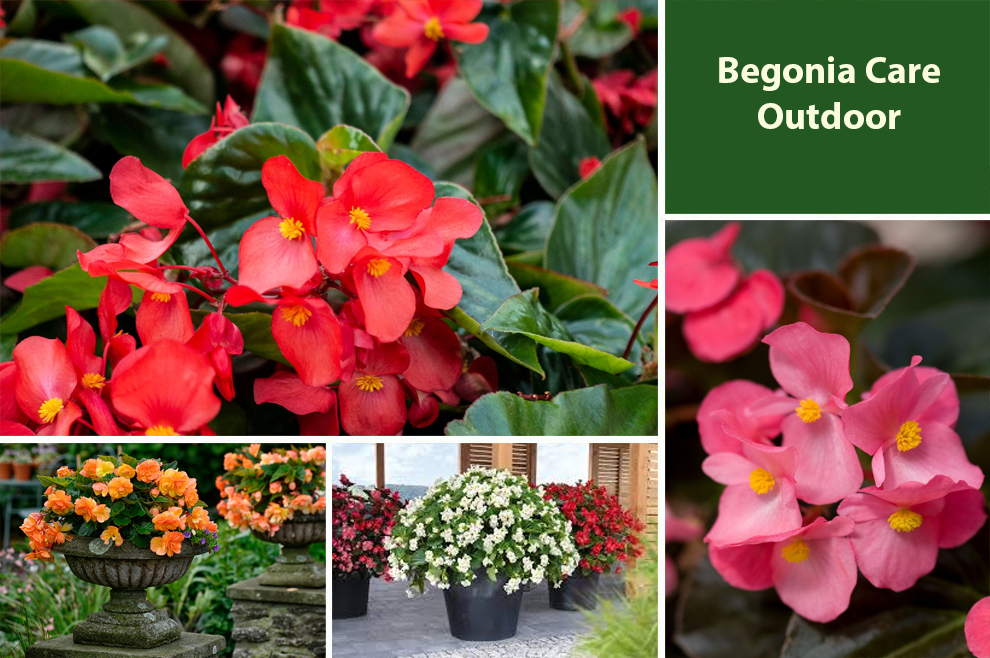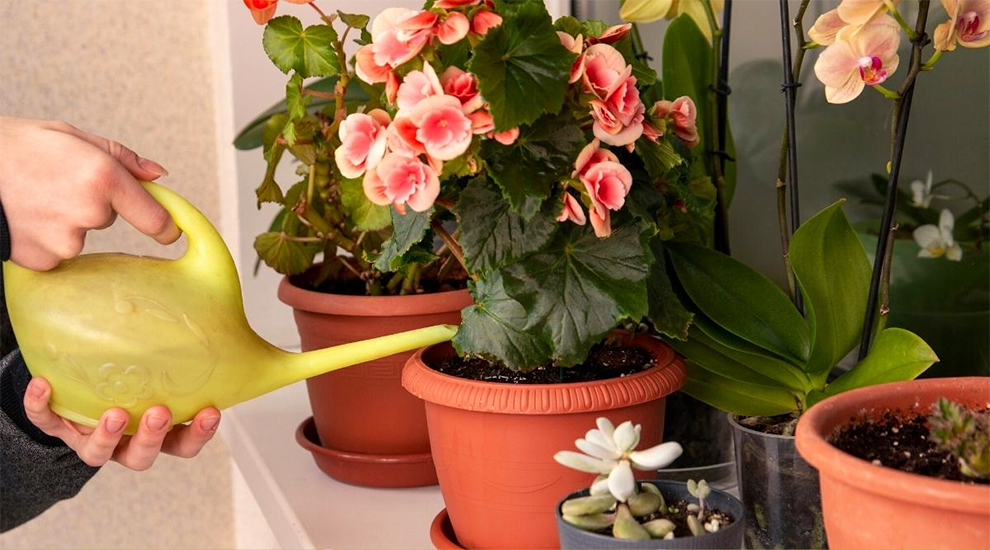Begonia Care Outdoors: How To Take Care Of Them Outside?
Begonias do not require any special care. Just like any other flowering plant, you need to feed them with a balanced fertilizer, provide indirect bright sun, and water regularly, and make sure the soil remains well-drained but not waterlogged.

Begonias are the preferred variety of flowers for many gardeners due to their low-maintenance nature. Some varieties of begonias such as the PicoTee or Dragon Wing Begonia are extraordinarily beautiful and hard to miss.
While not difficult to grow, some gardeners struggle with managing their rigid water requirements. Moreover, watering is not the only aspect of caring for the begonias outside.
There are other care factors to keep in mind. So how to care for begonias outside? Knowing these can help you have them in your garden. Their colorful wonderous blooms can surely cheer you up on a sad gloomy day.
Most begonias cherish bright, indirect light, well-draining soil, a dose of balanced fertilizers along with regular pruning and deadheading.
Finding the correct balance in light conditions is imperative to ensure their vitality and health. Ensuring well-draining soil is crucial for begonias to avoid root rot and overwatering. Keep the soil consistently moist but not overly saturated.
Feeding is necessary for optimal blooming and growth. Use a balanced, water-soluble plant food exquisitely formulated for flowering plants to provide crucial nutrients.
Regular deadheading and pruning are necessary to maintain the shape of the plant and encourage new blooms and growth.
This was just the gist of it. Let us look at taking care of begonias planted outside in detail.
First Things First – Can Begonias Be Planted Outside?
Yes. You can plant begonias outside. They are typically grown outdoors in different settings, such as containers, hanging baskets, and garden beds. Please pick the apt begonia variety and consider the specific growing conditions of your region for successful outdoor planting.
When Can I Plant Begonias Outside?
The ideal time for plating begonia outdoors depends on the climate and your location. Typically, begonias are warm-season plants. They like temperatures over 60°F (15°C). They are usually planted outdoors once the last frost date in the spring passes.
It is when the soil has warmed up. You must ideally wait until the frost risk has passed and the weather is mildly consistent.
In case of confusion, you can speak to your local gardening resources or consult an experienced gardener in your area to know the preferable time for planting begonias in your location.
How To Take Care Of Begonias Outside?
Caring for begonias outdoors involves multiple aspects, such as maintaining the soil conditions, sun exposure, proper watering, pruning, and fertilizing.
Let us delve into these care tips to ensure the vitality and health of your begonias in an outdoor setting.
A. Pick The Correct Variety For Outdoors
If after following everything about begonia care outside, you see your plant struggling, it is because you chose the wrong variety.
You must only select the varieties suitable for outdoor conditions. Not all begonias can thrive equally in outdoor environments.
Look for varieties like angel wing begonias (Begonia coccinea), dragon wing begonias (Begonia Dragon Wing), or wax begonias (Begonia semperflorens).
These are well-suited for outdoor plantation and are known for their ability to withstand varying weather conditions, courtesy of their durability.
B. Pick The Correct Location
Picking a suitable location is another vital aspect. So, when choosing the spot to keep your begonias, consider the specific needs of your planted begonia variety.
Begonias thrive in partial shade or bright, indirect sunlight. So, you can grow them in areas with filtered morning or evening sun. Do not place them in sites with intense or direct sun, as it can scorch the leaves.
Further, opt for a location with well-draining soil to avoid root rot and waterlogging. Begonias also like protection from solid winds, as they can damage their delicate foliage.
By cautiously picking the right location that offers the plant apt lighting conditions, protection from harsh conditions, and ample soil drainage, you build a conducive environment for your begonias to thrive.
C. Do Begonias Grow Better In Pot Or Ground?
Fortunately, you can grow begonias both in ground or pots. The choice primarily depends on two factors.
Pot plantation has the advantage of flexibility and mobility. Hence, you can move your containers to different locations to guard them against extreme weather and optimize sun exposure. It also ensures better control over soil quality and drainage.
On the contrary, begonias growing in the ground can establish a solid root system and have better access to larger soil volume. It results in more vigorous and extensive plant growth.
Furthermore, ground planting lets the plants benefit from natural nutrients and microorganisms in the soil.
Finally, the decision between pot and ground planting boils down to your preferences and other circumstances, such as desired aesthetics, available space, and the needs of your chosen variety.
D. Soil Type To Keep Your Begonias Alive
The correct soil type is crucial to keep your begonias thriving and alive. Begonias do best in well-draining soil that retains moisture sans becoming waterlogged.
A recommended soil mixture for begonias is one with equal parts of high-quality potting mix, perlite, and peat moss. This blend ensures good drainage while simultaneously ensuring required moisture retention.
Further, amending the soil with organic matter like compost can accentuate its nutrient content and better overall soil structure.
Do not use heavy clay soils that can hold excessive water or sandy soils that drain too fast. Regularly checking the soil moisture level and adjusting the watering practices is crucial for establishing ideal growing conditions for the begonias.
E. What Temp Is Too Cold For Begonias Outside?
Begonias are sensitive to cold weather and can be killed or damaged by frost. As a general guideline, temperatures <50°F (10°C) are too cold for the begonias.
But the specific cold tolerance may vary depending on your grown variety. Some varieties are relatively more cold-hardy and can endure temperatures slightly below this threshold, whereas others are more sensitive and need warmer conditions.
You must monitor the weather forecasts and guard begonias when temperatures drop close to or below their tolerance limit. Hence, cover the plants with frost cloth or bring them indoors if you are unable to provide the needed begonia care outside.
F. How Much Water Do Begonias Need?

Begonia’s water needs can vary depending on the climate, growing conditions, and the variety. Typically, they cherish moist soil but are prone to root rot if overwatered. Hence, you must strike a balance and avoid over and underwatering.
As a golden rule of thumb, water begonias whenever the top soil inch feels dry to the touch. It translates to watering them about once or twice a week, but alter the watering frequency based on your specific conditions.
Water thoroughly, letting the water penetrate the root zone, but ensure proper drainage to prevent waterlogging. Regularly inspect the moisture level and alter the watering accordingly to keep the soil moist, not waterlogged.
G. Do You Need To Fertilize Begonias Outdoors?
Fertilizing begonias is usually recommended to support their growth and blooming. While begonias are adaptable plants, offering them adequate nutrients can help with their vigor and overall health.
Use a balanced, water-soluble plant food exquisitely formulated for flowering plants. Start feeding in early spring and fertilize every four to six weeks across the growing season.
But do not over-fertilize, as too much feeding can result in burned foliage or weak growth. Always follow the packaging instructions and do not apply over the recommended dosage.
Do not forget to water the plants before and after fertilizing to avoid fertilizer burn and ensure proper nutrient absorption.
Pruning and Deadheading Begonias
Deadheading and pruning are crucial for maintaining the plant’s appearance and promoting healthy growth. Regular pruning helps manage size, shape the plants, and encourage bushier growth.
Trim leggy stems or remove damaged or diseased foliage to maintain an attractive and tidy appearance of your begonias.
Deadheading, which involves removing spent flowers, is beneficial as it redirects the plant’s energy toward new growth and encourages continuous blooming.
While deadheading, cut back the flower stalk to a little above the lateral shoot or healthy leaf node. This practice can prevent the formation of seed pods, allowing the plant to divert its energy toward producing more flowers.
Regular deadheading and pruning across the growing season help keep the begonias looking their best.
Winter Begonia Care Outdoors
Winter care is imperative to guard the plants against adverse weather and cold temperatures. Otherwise the lifespan of begonias gets cut short.
Here are some crucial tips for winterization:
1. Frost protection: Typically, begonias are frost-sensitive. So, during a frost forecast, cover the plants with frost blankets. Alternatively, you can move your potted begonias to a protected location or bring them inside.
2. Lower watering frequency: During winters, the begonia growth rate diminishes. Hence, you must alter the watering frequency and let the soil dry between waterings to avoid root rot and waterlogging.
3. Mulching: Apply a thick organic mulch layer around the begonia’s base to insulate the roots and guard them against temperature fluctuations. It can help retain moisture and provide insulation against the cold.
4. Cleanup and pruning: Trim damaged or dead foliage before the winter sets in. It lowers the pest and disease risk and benefits the plant by conserving energy during dormancy.
5. Provide shelter: Lastly, if you reside in an extremely cold region, provide added protection by moving the plants to a sunroom, greenhouse, or other sheltered area for the winter.
By following these winter care tips, you can help ensure the survival and health of your begonias during the colder months.
Pests and Diseases – What Is Attacking My Begonias?
Several diseases and pests can attack begonias. Here are some common ones to watch out for:
1. Aphids: These small, soft-bodied insects suck sap from leaves and stems, causing distortion and yellowing. You can control them by spraying them with insecticidal soap or horticultural oil.
2. Spider mites: These tiny pests are known for spinning webs on leaves. They suck plant juices, leading to yellowing and wilting. Regular misting and insecticidal soap can help control them.
3. Mealybugs: These pests appear as small, white, cottony clusters on leaves and stems. They feed on plant sap and excrete honeydew, leading to leaf yellowing and sooty mold. For begonia care outdoors, use a cotton swab dipped in rubbing alcohol to remove them.
4. Powdery mildew: This fungal disease causes a powdery white coating on leaves. Improve air circulation, avoid overhead watering, and apply fungicides as needed.
5. Botrytis blight: This fungal disease causes brown spots, rotting, and wilting of leaves and flowers. Remove and destroy infected plant parts, improve ventilation, and avoid overwatering.
Proper watering, regular inspection, good plant hygiene, and ample air circulation can help manage and prevent pest and disease issues. Contact a local gardening expert for specific treatment options if the disease or infestation is severe.
